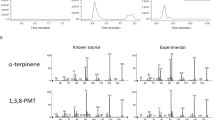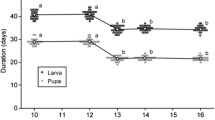Abstract
We studied case construction behavior of bagworm moth, Eumeta crameri (Lepidoptera: Psychidac) in the host plant, Acacia nilotica, at two sites. At the time of the study, Site A had 1-year-old A. nilotica saplings only, whereas Site B had full grown trees. The larva of bagworm moth used either thorns or cut-twigs or both as the materials for building its case. It renovated its case three times, and during each instance it increased the volume of its case by replacing older thorns or cut-twigs by newer and longer ones. However, it exhibited a spectacular predilection for thorns, irrespective of the sites, during the first-instar stage of its development. Thereafter, at Site A it used exclusively cut-twigs, whereas at Site B it preferably used thorns provided they were available in the range of the required length and within the threshold distance. It appears that the bagworm has an ability to process thorn length and distance signals hierarchically to fulfill its priority, that is, case building. Thus it optimizes time and energy expenditures during the period of its larval growth leading to pupation by toggling its preference between thorns and cut-twigs.
Similar content being viewed by others
REFERENCES
Agrawal, A. (1997). Studies on Bagworm (Lepidoptera: Psychidae) of the Chhattisgarh Region with Special Reference to Biology, Taxonomy, and Insect-Plant Interaction, Ph.D. thesis submitted to Pt. Ravishankar Shukla University, Raipur.
Agrawal, A. (1999a). Stick arrangement pattern in bagworm: Is it chaotic? National Seminar on Biological Bases of Behavior, organized by Centre of Advance Study in Psychology, Utkal University, Bhubaneswar, Jan. 11–13.
Agrawal, A. (1999b). Stick arrangement pattern in bagworm: Chaotic or rhythmic? National Seminar on Recent Advances in Pineal Research, organized by Department of Zoology, Government College of Science, Raipur, Feb. 5–7.
Agrawal, A., and Pati, A. K. (1995). Nest architecture of a bagworm species: Rhythmic pattern in the arrangement of sticks. J. Biosci. 20: 409-416.
Agrawal, A., Pati, A. K., and Karkun, D. (1997). Seasonal variation in infestation characteristics of bagworm (Lepidoptera: Psychidae) in avenue plantation of Acacia and Peltophorum in the Chhattisgarh region. Curr. Sci. 72: 211-214.
Ameen, M.U., and Sultana, P. (1977). Biology of the bagworm moth Eumeta crameriWestwood (Lepidoptera: Psychidae) from Dacca, Bangladesh. J. Nat. Hist. 11: 17-24.
Davis, D.R. (1964). Bagworm moths of theWestern Hemisphere. Smithson. Inst. U.S. Natl. Mus. Bull. No. 244.
Enoki, M. (1983). Ecology and control of the giant bagworm, Clania variegata Snellen, injurious to landscape trees. 1. Population and seasonal trends in urban areas (Japan). Bull. Osaka Agr. Res. Centre (Japan) 20: 41-53.
Hansell, M. H. (1985). Ethology. In Kerkut, G. A., and Gilbert, L. I. (eds.), Comparative Insect Physiology, Biochemistry, and Pharmacology, Vol. 9. Behaviour, Pergamon Press, London, pp. 1-94.
Heather, N.W. (1976). Life history and biology of the leaf bagworm, Hyalareta huebneri (Westwood) (Lepidoptera: Psychidae) (pest of orchards, pine plantations, ornamentals). J. Austral. Entomol. Soc. 14: 353-361.
Howlader, M.A. (1992). Host range, suitability of host plants as food, and seasonal abundance of the bagworm moth, Pteroma plagiophleps Hamps (Lepidoptera: Psychidae), in Bangladesh. Bangladesh J. Zool. 20: 177-183.
Kaufmann, T. (1968). Observation on the biology and behavior of evergreen bagworm moth, Thyridopteryx ephemeraeformis (Lepidoptera: Psychidae). Anu. Entomol. Soc. Am. 61: 38-44.
Krishnan, R. (1977). Larval biology of Crematopsyche pendula Joannis (bagworm, a crop pest). Planter (Malaysia) 53: 381-394.
Mathew, G., and Nair, K. S. S. (1986). Bagworms (Lepidoptera: Psychidae) of Kerala-Their potential as pests of tree crops. Proc. Vol. 2, Proc. III Oriental Entomol. Symp. 2: 163-167.
Nair, K. S. S., and Mathew, G. (1992). Biology, infestation characteristic and impact of the bagworm, Pteroma plagiophleps Hampson, in forest plantations of Paraserianthes falcataria. Entomon 17: 1-13.
Neal, J. W., Jr., and Santamour, F. S., Jr. (1990). Biotic indicators of host preference by the bagworm (Lepidoptera: Psychidae). J. Econ. Entomol. 83: 2393-2397.
Richards, O. W., and Davies, R. G. (1977). Imm's General Textbook of Entomology, 10th ed., Chapman and Hall, London, p. 135.
Snedecor, G. W., and Cochran, W. G. (1994). Statistical Methods, Iowa State University Press, Ames.
Author information
Authors and Affiliations
Rights and permissions
About this article
Cite this article
Pati, A.K., Agrawal, A. Hierarchical Perception of Stimuli During Case Construction in the Bagworm Moth Eumeta crameri (Lepidoptera: Psychidae). Journal of Insect Behavior 13, 667–677 (2000). https://doi.org/10.1023/A:1007839926460
Issue Date:
DOI: https://doi.org/10.1023/A:1007839926460




